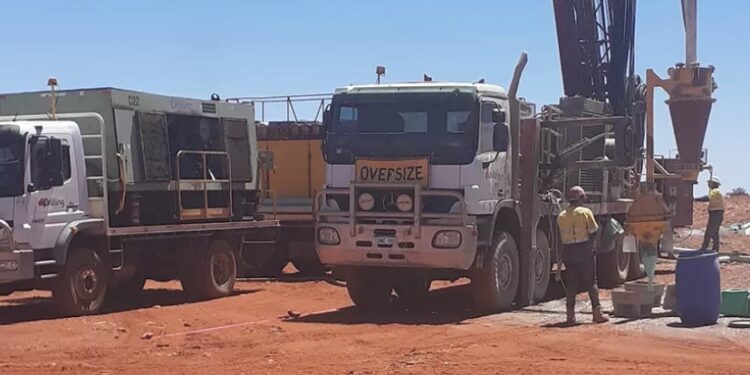Magnetic Resources (ASX:MAU) has intersected multiple, both thick and high-grade zones, starting from surface at the Lady Julie project in Western Australia during its most recent infill and extension drill programme.
These promising anomalous gold zones are still open to the SE as shown up by hold MLJRC448 with an intersection of 88m at 1.3g/t from 68m. This promising southern part of the Lady Julie North 1 target zone area is being tested in detail over a 1km length with 33 RC holes planned for 3518m averaging 107m per hole.
The Lady Julie 1 mineralisation can be unusually thick with associated higher grades, 41m at 2.6g/t from 31m in MLJRC162, 52m at 1.7g/t from 52m in MLJRC352, 52m at 1.5g/t from 15m and 88m at 1.3g/t from 68m, which augers well for the potential economics considering a lot of the intersections also start from surface, 25m at 4.4g/t from 0m in MLJRC348, 22m at 4.1g/t from 0m in MLJRC457.
This 1km long zone is being infill drilled to get it to an Indicated Category. There are at least two separate stacked lodes present in this current drilling area, which dip 20 to 45 deg to the east.
The gold mineralisation at Lady Julie 1 can occur within the porphyry or along the porphyry/mafic and porphyry/ultramafic unit contacts. Locally there is a strong concentration within the ultramafic as well, where there is higher grade mineralisation. Also, the alteration is usually a strong pervasive silicification alteration and numerous quartz veins as well.
Thickened porphyry zones (up to 70m) are common on the eastern part of the Lady Julie North1 strongly mineralised zones, on the edge of a major 6km long NS thrust zone. These porphyries are also steeper dipping in this area and may represent conduits for deeper mineralisation to come closer to the surface. These underlying intrusions are also targets for deeper mineralisation similar to the deeper intrusions at depth at the world class Sunrise Dam gold mine.
The next drill programme of 33 RC holes for 3578m will be testing between 100 to 250m depth looking for further enriched zones, defining the different stacked zones and vertical mineralised shoots. This programme will also assist in the location of deeper holes into the underlying porphyry and porphyry contact positions.
Infill RC drilling within the very high-grade intersection zones have shown that they are associated with pervasive vertical zones (shoots) with grades greater than 10g/t. Some of these intersections include 2m at 21.4g/t from 43m in MLJRC292 and 2m at 21.0g/t from 3m in MLJRC457 and 1m at 59.5g/t from 22m in MLJRC348 and 4m at 15.1g/t form 32m in MLJRC453.
Further infill RC and diamond drilling is designed to define the true extent and distribution of these enriched high-grade shoots that lie within the promising thicker intersections.
Within the HN5, HN6, HN9 and Lady Julie areas there are many new shallow intersections with a total of 1,626 intersections (ranging from 1.0m to 30m) greater than 0.5g/t Au, which includes 717 greater than 1g/t Au, 269 greater than 2g/t Au, 148 greater than 3g/t Au and 91 greater than 4g/t Au.
The results from the 2D seismic survey and the recent major drill programmes as well as historical drillings results have led to the interpretation of 15km of gold targets in 10 areas within HN5, HN6, HN9 and Lady Julie outlined in purple in Figure 2 and summarised in Table 2.
The best-looking target so far besides the 3km-long HN9 mineralisation, is Lady Julie North (3.9km long) At Lady Julie North 1 there are many mineralised intersections including the outstanding intersection of 41m at 2.6g/t Au from 31m including 15m at 4.2g/t from 52m in MLJRC162, 25m at 4.4g/t from 0m in MLJRC348 and 36m at 2.0g/t from 92m in MLJRC448.
This zone between the two thrusts is very prospective and there are numerous NS workings, mineralised drillholes and anomalous soil geochemical areas, which are in the process of being further drilled.
Both the mineralised targets at HN9 and Lady Julie North appear to straddle two deep seated thrusts, with HN9 being a major 3km-long mineralised zone. The eight thrust zones that come to surface continue to the north and south over an extensive 6km length and shallow RAB and or soil geochemistry is being planned to help outline any further anomalous gold areas worthy of follow up drilling. At Lady Julie North 1 and 2, the targets are compelling because they are associated with the two parallel Thrusts 7 and 8.
At Hawks Nest 5, 6, 9 and Lady Julie extensive drilling programmes have been completed, including 1,552 RC holes totalling 107,147m (average 69m depth) 26,344 2–5m composites and 16,231 1m splits and 4 Diamond holes totalling 431m. This release is mainly reporting on 645 composite assays (2-5m) and 994 1m splits from 45 RC holes (MLJRC369,372,374,375,377,379-384,399-413,422,427-429,445-458) totalling 5,154m. A further 25 RC holes for 2,640m have assays pending.
An RC rig is starting shortly with a programme of 33 RC drillholes for 3,518m following up the new assays reported on at Lady Julie North 1, which is designed to test and extend all the gold mineralisation found with the aim of ultimately converting to an Indicated Resource.
There are now at least two discernible mineralised lodes recognised that mostly dip shallowly between 20-45° to the east at Lady Julie. These multi-stacked thickened lodes show similarities with the adjacent Wallaby, Sunrise Dam and Jupiter major gold deposits.
For further information please visit: https://magres.com.au/












